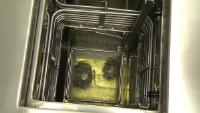 Add My Company
Add My Company
Sign In
VAPOR DEGREASING – NEED TO KNOW
12-10-2019

VAPOR DEGREASING – AN INSIGHT TO THE PROCESS
Vapor Degreasing or condensing so as to degrease is the procedure of cleaning parts solvent vapors on work pieces. It utilizes the hot vapours of a chlorinated or fluorinated solvent to evacuate soils, especially oils, greases, and waxes. A vapor degreasing unit comprises of a steel tank with a heated solvent reservoir, or sump, at the base and a cooling zone close to the top. Adequate heat is acquainted into the sump with boil the solvent and create hot solvent vapour. Since the hot vapor is heavier than air, it uproots the air and tops the tank off to the cooling zone. The hot vapor is consolidated when it achieves the cooling zone, along these lines keeping up a settled vapor level and making a thermal parity. The temperature differential between the hot vapour and the cool work piece causes the vapour to gather on the work piece and break down the soil.
THE PROCESS
The soils expelled from the work pieces as a rule boil at much higher temperatures than the solvent, which brings about the development of basically unadulterated solvent vapors, despite the fact that the boiling solvent may be very defiled with soil from past work parts. In vapor degreasing, the parts are heated by build up of the solvent vapours to the boiling temperature of the degreasing solvent, and they dry in a flash as they are pulled back from the vapour zone. Solvent soundness is typically controlled by the expansion of stabilizers when the solvent is fabricated. Most regular chlorinated solvents all oblige stabilizers to perform effectively in vapor degreasing.
THE FRAMEWORK
The least complex type of degreasing framework utilizes the build up of solvent vapor just. If the work piece contains visually impaired openings or breaks that are not available to the vapor, or if the soil can’t be uprooted by the vapour, a spray stage may be included. The framework then comprises of vapour – spray – vapour stages. Different techniques incorporate warm liquid-vapour, boiling liquid/warm liquid-vapour frameworks. Likewise ultrasonic cleaning can be utilized as a part of conjunction with the vapour degreasing process.
At the point when a ferrous metal is vapor degreased, organic films are generally evacuated, and the metal is exceedingly helpless to atmospheric consumption. At the point when accuracy steel parts with a high surface completion (e.g. antifriction direction) are being degreased and finish rust counteractive action is coveted, rust flushing so as to seal or submersion ought to be incorporated as a vital piece of the degreasing framework.
Advantages of vapor degreasing incorporate:
• Can be utilized on electronic parts to uproot overabundance oil, grease, wax and other non-water dissolvable particles
• Cleans and gets ready part surfaces for different completing procedures like painting, welding, patching and bonding.
• Does not bring about part oxidation or water spots
• No solvent radiated with vacuum degreasers
One drawback of vapor degreasers is that they have a high cost and low generation rate.
For more information on VAPOR DEGREASING – NEED TO KNOW talk to Supersheen (midlands) Ltd
Enquire Now
List your company on FindTheNeedle.

